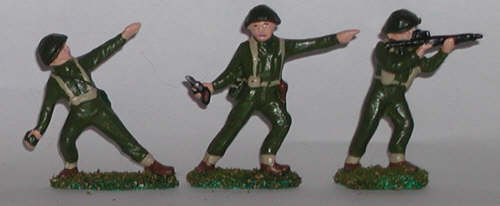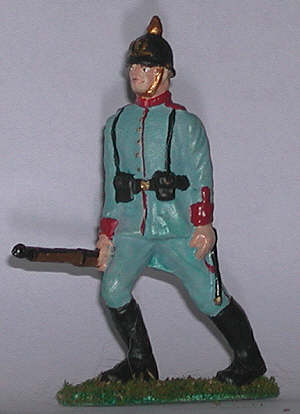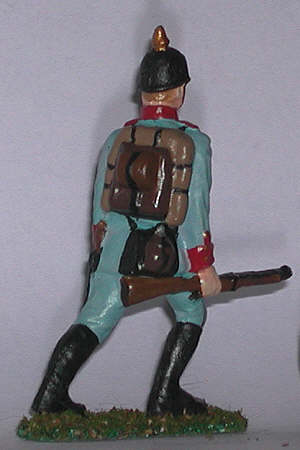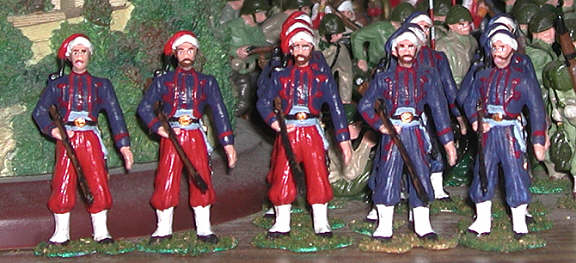
Copyright 2008 All Rights Reserved
Unique Troops

The figures above are from Castings Mold #6091 Commando Raiders. They are copies of Herald's Khaki Infantry, a set of British soldiers circa 1955. This set has an anachronism. At the time, the British Army was testing a "bullpup" type assault rifle to replace the old Enfield They were very close to accepting it. Thinking it would put them ahead, Herald designed its figure set with the experimental weapon. Lone Star and Cherilea followed suit by arming their next sets of paratroopers with the yet-unofficial weapon. The story ends with the British Army foregoing the weapon.
A similar thing happened to the American firm Tim Mee / Processed Plastic. They designed their Vietnam-era soldier with a magazine-fed experimental version of the M60 machine gun. Like the Bren, the magazine fed from the top. It was not adopted by the U.S. Army.
The British soldiers above wear khaki tan belts and leggings. Going back to the 1930s, the webbed gear was issued in a medium green, but soon faded to khaki tan.


This German soldier circa 1870 - 1910 came from an unusual mold. He is about 65mm scale, and resembles a pose from Schildkrot Zinnbrigade's 40mm Prussians. The other figure in the mold is a standing Prussian from the Napoleonic era.
I painted this one in Bavarian colors. The uniform is light blue (helblau) with red facings. He has pretty good detail. This is the first of these figures I have painted. Future plans include painting them in Prussian, Sachsen and colors of other stadts.
Prussian versions of the uniform tended toward dark blue, while several other stadts preferred hunter green.
You can tell that this soldier is pre-1914 by the ammo pouches. His are a simple one-pocket version. By World War one, the Germans were issuing multi-pocket pouches.

Zoaves were a type of light infantry which were first encountered in North Africa. The French employed them, and they proved quite effective during the Crimean War. By then, most French Zouaves were not North Africans, but Europeans. The gaudy uniforms and equipment made them popular. Many American militia units adopted the Zouave uniform and organization. During the Civil War, both sides fielded Zouave units. Pictured above are the 5th New York and 33rd New Jersey.
Toys notwithstanding, the actual Civil War Zouaves slowly adapted to battlefield reality. Most of the gaudy uniforms disappeared by the second year of the war. France retained Zouave units right into the early 20th century. Below is a Zouave unit during the Boxer rebellion:

This is a small part of the Toy Soldier Art, and there will be more to come.
Contact Us at thortrains@comcast.net